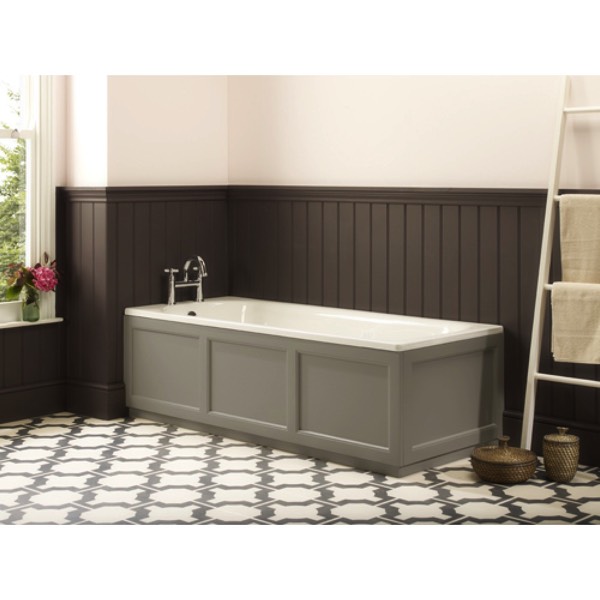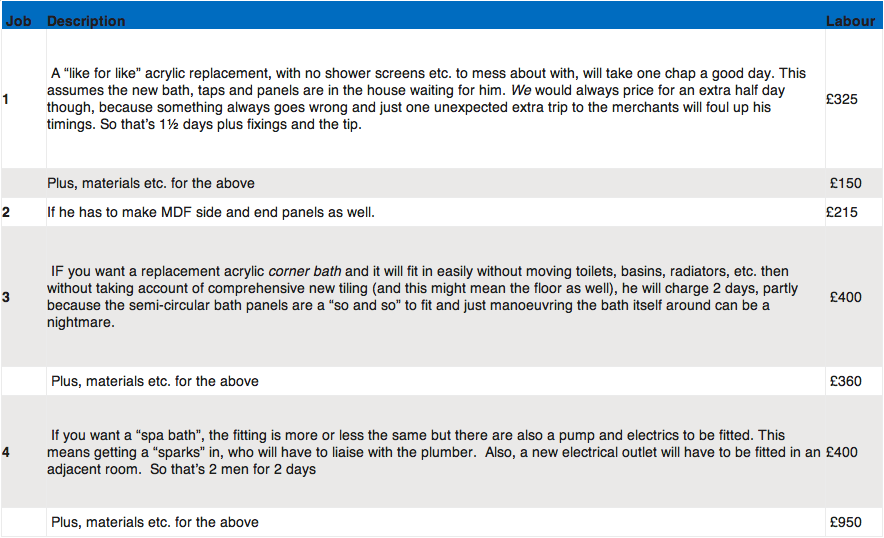How Much Does It Cost To Fit a Bath?

Cost to fit a bath

“Labour” at £175 a day (tradesman) £100 (labourer), includes incidental fixings etc. and tipping. “Materials” if mentioned, are larger things (a boiler) and stuff only you can choose (tiles etc). Also VAT must be added all round.
Information Sheet on Fitting a New Bath
Which design of bath do you want?
“Normal”? Normal with a bulge in it for easier showering? One with the taps and plug hole (builders call this the “waste”, not the waste hole, just the “waste”) in the middle, (and a shelf for some aromatic candles and space for two glasses and a champagne bottle)? A corner bath? A spa bath? A free standing bath set right in the middle of the room, (just right for bathing the boys in, you didn’t like that downstairs ceiling anyway).
Which type of bath do you want?
Do you want cast iron? The builder won’t! The only advantage of cast iron for a “normal” bath is it doesn’t creak when you stand in it. But then, if the other types are secured properly nor should they. Free standing ones will be cast though. So they should be at 2 grand a throw! Do you want acrylic? These are a bit like buying a Skoda. There’s absolutely nothing wrong at all with them but…
Do you want pressed steel? People used to buy steel because they didn’t want to splash out on cast and to avoid buying acrylic. There’s no difference as far as efficiency of the bath is concerned between steel and acrylic…. AND with acrylic you get matching, contoured side and end panels. Make sure these are supplied with the bath though, as sometimes they are not and have to be paid for separately. Will you ever use the bath? You might always use the shower?
Bath Removal Procedure
Right… you’ve decided on the new bath and it’s in a box in the back bedroom.
Removing the old one is a bit of a faff because you now have a bathroom surrounding it. When it was fitted it was the first thing in the room remember. If the old one is cast iron it will most likely be smashed to pieces where it is. This is incredibly noisy and might upset you – go and do a bit of shopping till it’s all over and take the dog with you. The noise makes fireworks night sound like the gentle ticking of a Swiss watch. It makes a Formula 1 car sound like the gentle ticking of a Swiss watch!
The new bath will very likely be a different size and won’t exactly fit the existing tiling. Unlike basins and toilet cisterns which, if fitted properly, should have had the walls behind them tiled before they were fitted, the walls adjacent to a bath are almost always tiled after it’s fitted. This is usually to make up for the fact that the corner the bath fits into, is never exactly square.
So unless you are lucky and any difference can be covered by the new silicone seal, you will have to re tile, because there is no way you will be able to get matching ones anymore.
If the new bath is “like for like”, the tap connections and waste pipework will be sitting there already and with a bit of fiddling around will be fine for the new unit. If you have decided on one with the taps and waste in the middle, then there will just be more fiddling. There is enough space under a bath to reconfigure wastes and supply pipework.
Finishing off the bath
A frame will have to be built to fix the side and end panels to. This will be a quite simple one if they are acrylic but more substantial for pressed steel and cast iron baths. These don’t come with panels, these have to be made on site. Decide what material you want, will it be tiled? Will you have an access panel so the taps can be “got at” in 5 years time when a leak develops, or if the “gold” starts to look a bit naff?
Sealing around the top is a serious business. All the old stuff must be completely removed. This is best done with a sharp chisel or Stanley blade then with silicone remover. When the new seal is applied it has to be sanitary silicone (with fungicide). Here is one area where you definitely get what you pay for. If he uses cheap silicone it will be black within a year.
Ideally, if he’s not an expert, he should apply masking tape first, this takes a bit of time but the application and smoothing become an absolute doddle and the job looks perfect afterwards. The bath should be filled before silicone is applied to allow for it dropping slightly under the weight of you and the water and this water should be left in the bath for 4-6 hours once sealed, so that the silicone can cure.
FAQs 'traffic light' guide
-
What's easy about this job…
Open or CloseIf all goes, well, it's just removing the taps and re-installing like-for-like.
-
What's tricky about this job…
Open or CloseTurning off the mains and draining down. Access to the taps.
-
Potential problems with regards to this job…
Open or CloseTaps may be seized on and an old bath. The old bath may have to be removed.
www.buildingsheriff.com
Copyright The Building Sheriff Ltd 2017